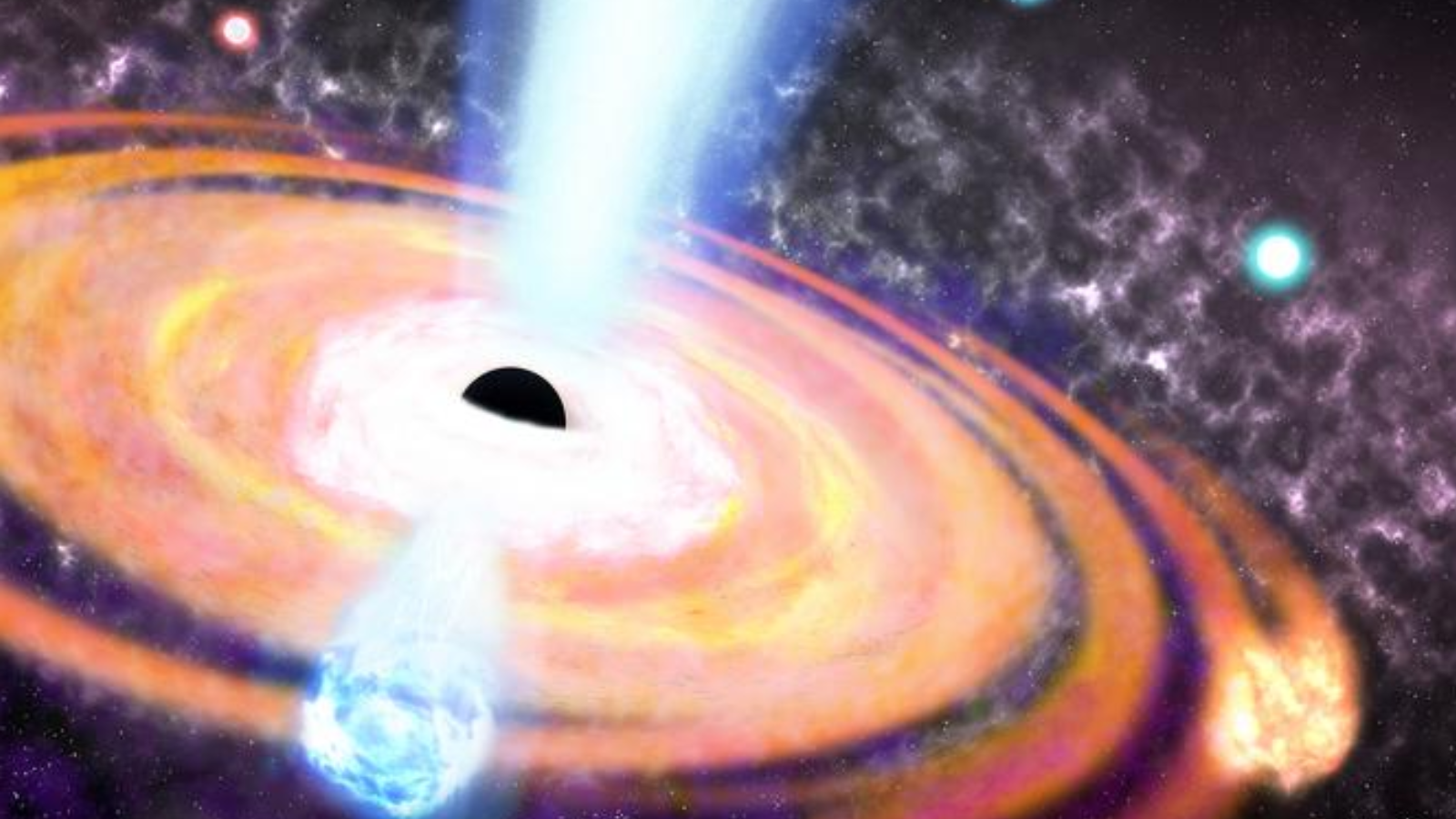Supermassive black holes bent the laws of physics to grow to monstrous sizes
Scientists have found evidence that black holes that existed less than 1 billion years after the Big Bang may have defied the laws of physics to grow to monstrous sizes. The discovery could solve one of the most pressing mysteries in space science: How did supermassive black holes in the early universe grow so big, so fast?
Supermassive black holes with masses millions, or even billions, of times that of the sun are found at the hearts of all large galaxies. They are thought to grow from a chain of mergers between progressively larger black holes, as well as sometimes through feeding on matter that surrounds them. Such feeding supermassive black holes cause the material that surrounds them (in flattened clouds called “accretion disks”) to glow so brightly they are seen at vast distances. Such bright objects are referred to as “quasars” and can outshine the combined light of every star in the galaxies they live in.
However, the processes that allow black holes to reach “supermassive status” are thought to occur on timescales greater than 1 billion years or so — that means seeing supermassive black hole-powered quasars 500 million years or so after the Big Bang, as the James Webb Space Telescope (JWST) has been doing, constitutes a massive problem (or a supermassive one even?) for scientists to tackle.
To crack this mystery, a team of researchers used the XMM-Newton and Chandra space telescopes to examine 21 of the earliest quasars ever discovered in X-ray light. What they found was that these supermassive black holes, which would have formed during an early universal epoch called the “cosmic dawn” could have rapidly grown to monstrous masses via bursts of intense feeding, or “accretion.”
The findings could ultimately explain how supermassive black holes existed as quasars in the early universe.
“Our work suggests that the supermassive black holes at the centers of the first quasars that formed in the first billion years of the universe may actually have increased their mass very quickly, defying the limits of physics,” Alessia Tortosa, who led the research and is a scientists at the Italian National Institute for Astrophysics (INAF), said in a statement.
The rapid feeding that these early supermassive black holes seemed to have indulged in is considered law-bending because of a rule called the “Eddington limit.”
The answer is blowing in the wind
The Eddington limit says that, for any body in space that is accreting matter, there is a maximum luminosity that can be reached before the radiation pressure of the light generated overcomes gravity and forces material away, stopping that material from falling into the accreting body.
In other words, a rapidly feasting black hole should generate so much light from its surroundings that it cuts off its own food supply and halts its own growth.
This team’s findings suggest that the Eddington limit can be defined, and supermassive black holes could enter a phase of “super-Eddington accretion.” Evidence for this result came from a link between the shape of the X-ray spectrum emitted by these quasars and the speeds of powerful winds of matter that blow from them, which can reach thousands of miles per second.

That link suggested a connection between quasar wind speeds and the temperature of X-ray-emitting gas located closest to the central black hole associated with that particular quasar. Quasars with low-energy X-ray emission, and thus cooler gas, seemed to have faster-moving winds. High-energy X-ray quasars, on the other hand, seemed to have slower-moving winds.
Because the temperature of gas close to the black hole is linked to the mechanisms that allow it to accrete matter, this situation suggested a super-Eddington phase for supermassive black holes during which they intensely feed and, thus, rapidly grow. That could explain how supermassive black holes came to exist in the early universe before the cosmos was 1 billion years old.
“The discovery of this link between X-ray emission and winds is crucial to understanding how such large black holes formed in such a short time, thus offering a concrete clue to solving one of the greatest mysteries of modern astrophysics,” Tortosa said.
The XMM-Newton data used by the team was collected between 2021 and 2023 as part of the Multi-Year XMM-Newton Heritage Programme, directed by INAF researcher Luca Zappacosta, and the HYPERION project, which aims to study hyperluminous quasars at the cosmic dawn of the universe.
“For the HYPERION program, we focused on two key factors: on the one hand, the careful choice of quasars to observe, selecting titans, that is, those that had accumulated the greatest possible mass, and on the other, the in-depth study of their properties in X-rays, never attempted before on so many objects at the cosmic dawn,” Zappacosta said in the statement. “The results we are obtaining are truly unexpected, and all point to a super Eddington-type growth mechanism for black holes.
“I would say we hit the jackpot!”
The team’s research was published on Wednesday (Nov. 20) in the journal Astronomy & Astrophysics.
Source link
